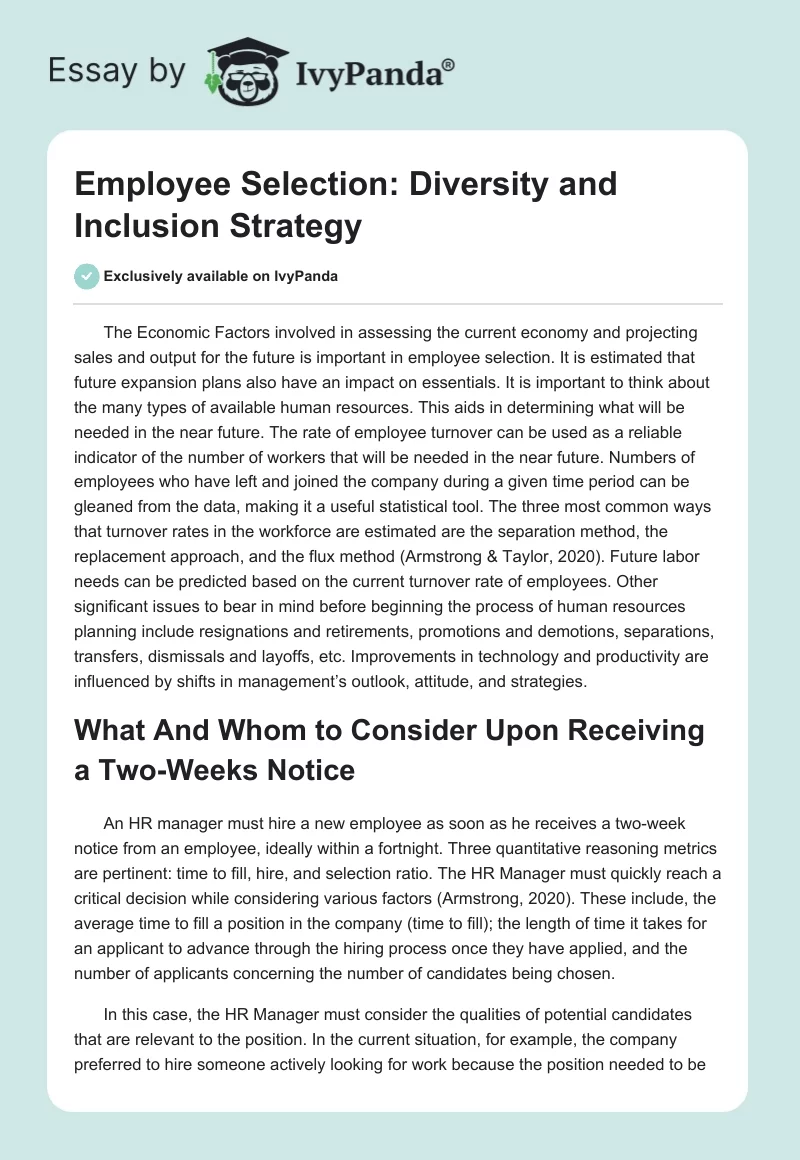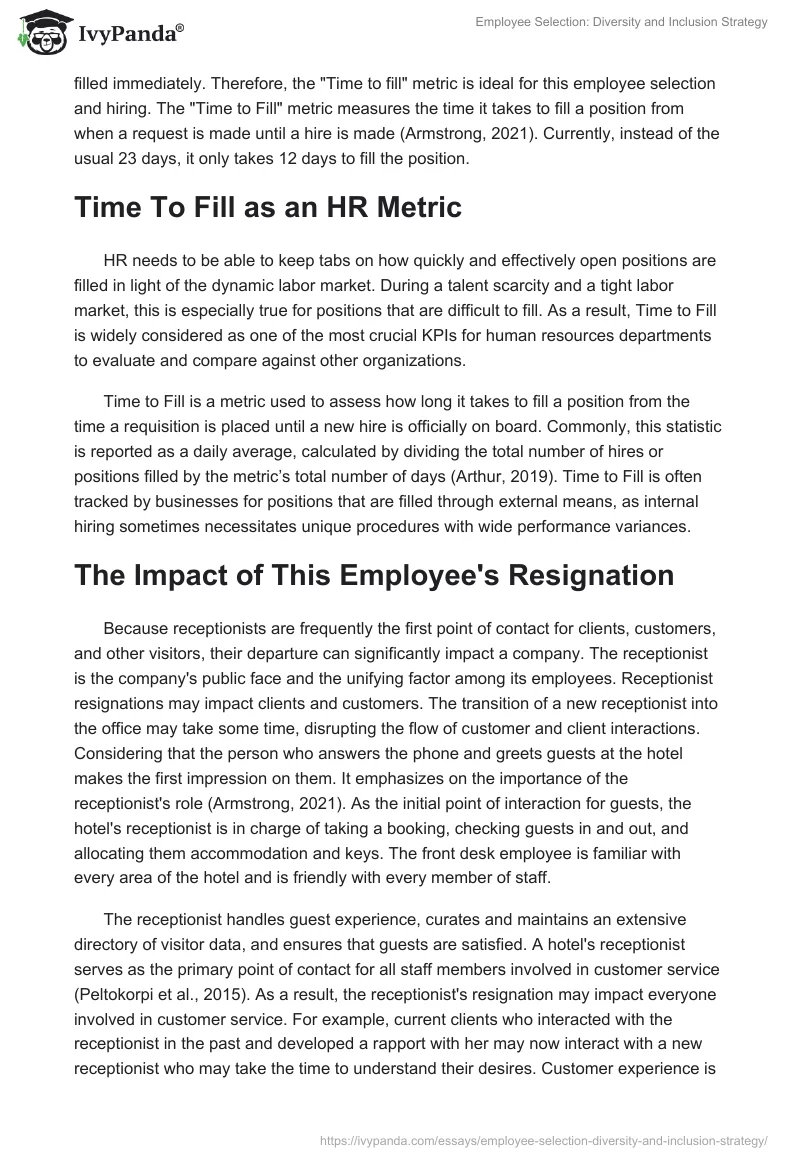The Economic Factors involved in assessing the current economy and projecting sales and output for the future is important in employee selection. It is estimated that future expansion plans also have an impact on essentials. It is important to think about the many types of available human resources. This aids in determining what will be needed in the near future. The rate of employee turnover can be used as a reliable indicator of the number of workers that will be needed in the near future. Numbers of employees who have left and joined the company during a given time period can be gleaned from the data, making it a useful statistical tool. The three most common ways that turnover rates in the workforce are estimated are the separation method, the replacement approach, and the flux method (Armstrong & Taylor, 2020). Future labor needs can be predicted based on the current turnover rate of employees. Other significant issues to bear in mind before beginning the process of human resources planning include resignations and retirements, promotions and demotions, separations, transfers, dismissals and layoffs, etc. Improvements in technology and productivity are influenced by shifts in management’s outlook, attitude, and strategies.
What And Whom to Consider Upon Receiving a Two-Weeks Notice
An HR manager must hire a new employee as soon as he receives a two-week notice from an employee, ideally within a fortnight. Three quantitative reasoning metrics are pertinent: time to fill, hire, and selection ratio. The HR Manager must quickly reach a critical decision while considering various factors (Armstrong, 2020). These include, the average time to fill a position in the company (time to fill); the length of time it takes for an applicant to advance through the hiring process once they have applied, and the number of applicants concerning the number of candidates being chosen.
In this case, the HR Manager must consider the qualities of potential candidates that are relevant to the position. In the current situation, for example, the company preferred to hire someone actively looking for work because the position needed to be filled immediately. Therefore, the “Time to fill” metric is ideal for this employee selection and hiring. The “Time to Fill” metric measures the time it takes to fill a position from when a request is made until a hire is made (Armstrong, 2021). Currently, instead of the usual 23 days, it only takes 12 days to fill the position.
Time To Fill as an HR Metric
HR needs to be able to keep tabs on how quickly and effectively open positions are filled in light of the dynamic labor market. During a talent scarcity and a tight labor market, this is especially true for positions that are difficult to fill. As a result, Time to Fill is widely considered as one of the most crucial KPIs for human resources departments to evaluate and compare against other organizations.
Time to Fill is a metric used to assess how long it takes to fill a position from the time a requisition is placed until a new hire is officially on board. Commonly, this statistic is reported as a daily average, calculated by dividing the total number of hires or positions filled by the metric’s total number of days (Arthur, 2019). Time to Fill is often tracked by businesses for positions that are filled through external means, as internal hiring sometimes necessitates unique procedures with wide performance variances.
The Impact of This Employee’s Resignation
Because receptionists are frequently the first point of contact for clients, customers, and other visitors, their departure can significantly impact a company. The receptionist is the company’s public face and the unifying factor among its employees. Receptionist resignations may impact clients and customers. The transition of a new receptionist into the office may take some time, disrupting the flow of customer and client interactions. Considering that the person who answers the phone and greets guests at the hotel makes the first impression on them. It emphasizes on the importance of the receptionist’s role (Armstrong, 2021). As the initial point of interaction for guests, the hotel’s receptionist is in charge of taking a booking, checking guests in and out, and allocating them accommodation and keys. The front desk employee is familiar with every area of the hotel and is friendly with every member of staff.
The receptionist handles guest experience, curates and maintains an extensive directory of visitor data, and ensures that guests are satisfied. A hotel’s receptionist serves as the primary point of contact for all staff members involved in customer service (Peltokorpi et al., 2015). As a result, the receptionist’s resignation may impact everyone involved in customer service. For example, current clients who interacted with the receptionist in the past and developed a rapport with her may now interact with a new receptionist who may take the time to understand their desires. Customer experience is one of the most important factors for commercial enterprises to maintain profit margins and efficiency, which could affect it (Arthur, 2019). Hence, it demonstrates how a receptionist’s resignation can affect organization’s productivity and revenue growth. As a result, a receptionist’s resignation may impact several people within the company, so the HR Manager must act quickly to mitigate any negative effects.
The Time-To-Fill for This Vacated Position
The amount of time it takes to find a suitable candidate to fill a vacancy is known as the time to fill. In this instance, the time to fill the receptionist position is 14 days because the employee gave that much notice before quitting, but the role was filled on the 12th day. Therefore, the new receptionist could only be trained for two days (Arthur, 2019). Effectiveness in the hospitality industry depends on receptionist training because they serve as the focal point for the coordination of all business operations in a hotel. Customers can ask the receptionist for anything they require, such as a drink from the bar, a meal from the kitchen, or a washing service. The receptionist then relays their request to the appropriate employee and ensures compliance. The working relationship has not yet been established, implying that the current staff members would be liaising with a new receptionist unfamiliar with their work style. The working relationship shows how the employees have established a routinized cooperative method (Arthur, 2019). As a result, it helps to increase the workforce’s effectiveness.
Nevertheless, in the current scenario, there is limited time for the staff to establish a rapport because they must begin liaising with the new receptionist within a day. Hence, to lessen any negative effects on the company and its staff, the HR Manager must take all steps to fill the vacant receptionist position as soon as possible. This process might entail extensive job advertising, a comprehensive and efficient hiring procedure, and competitive pay and benefits to entice leading contenders (Armstrong, 2020). Hence, the HR department can organize a social gathering for the staff to help them get to know one another.
Effects of The Average Historical Time-To-Hire Timeline
The HR Manager must speed up the hiring process if the hotel’s historical average time to hire is 23 days and the receptionist has given two weeks’ notice to fill the position by the deadline. This process might entail giving some hiring process steps more importance while omitting or skipping others. The steps considered essential in the hiring process include defining the position and prerequisites, advertising the role, reviewing resumes and performing initial checkups, conducting interviews, and checking references. Following the hiring of a new employee, the employee should participate in training and development activities to help them become accustomed to the company’s culture (Arthur, 2019). However, the immediacy of the situation made it impossible to complete all of the steps. Furthermore, because the position was filled on the 12th day and the previous receptionist had given a 14-day notice, the new receptionist only had one to two days to train before taking over front-desk management (Armstrong, 2021). Such circumstances necessitate hiring highly qualified individuals who can begin working immediately after receiving minimal training.
An experienced worker for a demanding role can quickly meet the requirements of the role, depending on their expertise. The Time to Fill the metric is critical in this case due to the critical nature of the situation. Furthermore, the HR Manager could use various recruitment techniques to fill the position quickly, such as employee referrals and job postings on media platforms to capitalize on e-WOM, online job boards, and so on. A specific deadline period is not required (Armstrong, 2020). Without a set deadline, the job posting can emphasize the situation’s urgency and that the firm would hire immediately if a qualified applicant is found.
The Important HR Metric Learned
Numerous HR metrics may be crucial for the HR manager to consider when overseeing the hiring procedure and the entire HR function. The time to fill, however, is one metric that might be particularly significant in this case. The time to fill is a measurement of how long it takes to find a suitable candidate to fill a vacancy. The time to fill in this instance is 14 days because the receptionist gave that much notice before leaving. The time to hire, in this case, refers to how long it typically takes the organization to fill open positions. As a result, it provides the HR Manager with information about the specific hiring plan that is more beneficial in this particular circumstance. Knowing the rate of staff retention is also crucial for an HR manager. This data provides the HR Manager with information on staff happiness and organizational fidelity (Armstrong, 2021). Therefore, to limit any adverse effects on the company and its employees, the HR Manager must make every attempt to replace the vacant receptionist position as soon as possible.
Furthermore, the HR Manager can spot any prospective problems or opportunities for advancement within the company by monitoring on these and other HR metrics and then take the necessary steps to address them. Time to fill and time to hire are both supported by the staff turnover rate. Additionally, the organization’s culture and compensation plan need to be revised because the high employee turnover rate signifies the workforce’s discontent and demotivation.
Conclusion
Much like human resources, selection plays an essential role in the success of the business. In fact, the selection procedure has a direct impact on the quality of human resources. Accordingly, the selection process starts with the detection of openings in the organization and continues all the way to the induction of new workers. The HR department is responsible for making hiring decisions, but the line managers, supervisors, and employees all have a hand in finding the best candidates and narrowing them down. In a perfect world, both internal and external recruitment would play a significant role in filling open positions. Because it is a possible source of employee selection, the job search process is an essential aspect of the recruitment process as a whole.
References
Armstrong, M. (2021). Chapter 21: Diversity and inclusion strategy. In Armstrong’s handbook of strategic human resource management: Improve business performance through strategic people management (7th ed.). Kogan Page [Books 24/7].
Armstrong, M., (2020). Chapter 28: Recruitment & selection. In Armstrong’s Handbook of Human Resource Management Practice (15th ed.). Kogan Page.
Arthur, D. (2019). References and background checks. In Recruiting, interviewing, selecting, & orienting new employees (6th ed.). Harper Collins [Books 24/7].


